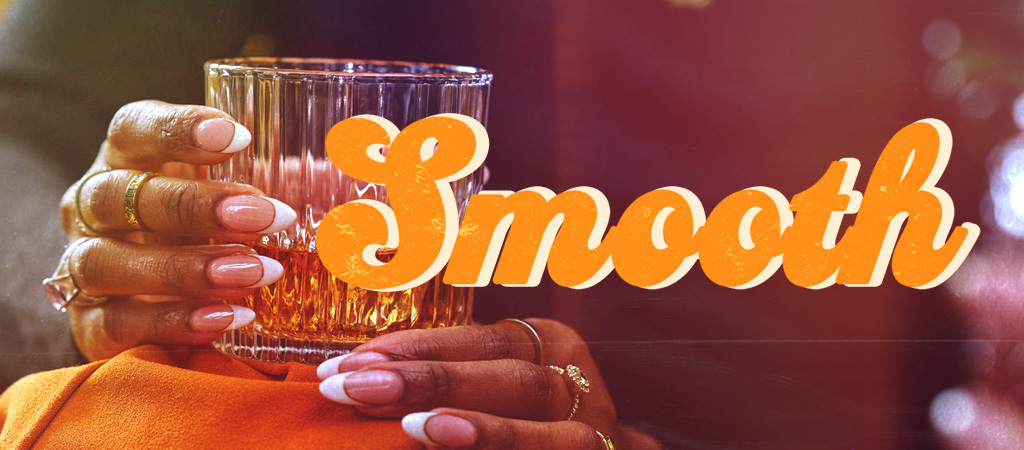The word “smooth” in whiskey (or spirits in general) circles is often the heart of a heated debate. It’s similar to asking a serious food lover whether a hot dog is a sandwich or not. It’s part zero-sum game and part bandwagonism, with teams that fall on both sides. Translation: It’s exhausting.
So do some whiskeys actually taste “smooth?” And is that really a bad thing?
Short answers: Yes and No. Take that zero-summers!
As a professional in the ol’ whiskey game, I can tell you that this comes up way more often than it should. Last year, our friends at Bourbon Pursuit posted a fun IG Reel from the Kentucky Bourbon Festival that has a lot of whiskey pros smirking and saying “smooth” is the most annoying word in whiskey.
I get it. “Smooth” has been run into the ground by consumers to the point that it lost a lot — if not all — of its meaning to some aficionados. “Smooth” feels like a cop-out term when you could dive deeper into flavor profiles or mouth feel. It can also be conflated with “thin” or “one-note” by newbies. Having worked in whiskey media for years, I can also tell you that consumers search for “smooth” whiskey/bourbon/scotch more by far than any other descriptor. So much so that it’s almost comical.
At the end of the day, we’re talking about mouthfeel and/or texture when we’re talking about smoothness. Consumers — the people paying the whiskey world’s wages by actually enjoying the stuff — like a whiskey they can drink. “Smooth” simply relates to the fact that there is little to no burn, no rough edges, and no imperfections that distract from enjoying the deeper flavor profile built into the pour.
Smooth can be a good thing wherein a whiskey has a great mouthfeel that allows you to enjoy the profile. But it can also be a fault wherein the smoothness doesn’t reveal any nuance besides “easy to down.”As with all things in our life, it can be two things. Life is grey and context-driven, not black and white.
Frank Dobbins — whiskey writer, influencer, and judge — puts it this way: “Smooth is a common descriptor for a reason. Longtime enthusiasts cringe at hearing it and yet it’s something most newcomers to the category are looking for.”
Dobbins hits on a key demographic here “newcomers.” I’ve said it before and I’ll say it again — no one likes that first mouthful of whiskey they taste when they’re young. It’s an acquired taste. You have to build up a palate for the heat of it, much less the nuances of the flavor profile. Forcing a Hazmat-proof (above 70%) whiskey on someone and expecting them to fall in love with whiskey is a wildly crazy ask. Whereas, offering someone, say, a Michter’s Small Batch Bourbon at 45% throws open the gates to a life spent loving whiskey. Why? You can taste those aforementioned nuances when the proof is lower and it won’t feel “rough.”
That Hazmat pour will feel like sipping whiskey with razorblades in it if you’re not ready for it. It’s hellish for newcomers.
Don’t believe me? Every single whiskey is tasted at 20%/40 proof in the lab by the distillers and blenders before it’s chosen for blending and bottling. Why? That’s the proof when whiskey presents the clearest profile, allowing faults and perfections to shine the clearest. Proof any whiskey down to 20% and it’s going to taste “smooth” while highlighting the most prominent flavor notes.
But there is more to the discussion than that. Nate Gana — whiskey investor, judge, writer, and international ambassador — notes that whiskey is never bottled at 40 proof.
“Whiskey is meant to be edgy and sophisticated and make you think about what’s in your glass.” Gana says that he understands why the term is used but that “whiskey is supposed to open your eyes wider. You’re meant to feel it in all your senses.”
Sometimes you have to feel the burn to feel the full brunt of a bourbon’s beauty. Still, Gana agrees that everyone has to start somewhere — so we’ll likely always have people looking for “smooth” whiskeys when they’re starting out.
Bob Book — whiskey judge and podcaster of the Film & Whiskey Podcast — has a clear sense of using smooth and says, “I honestly think ‘smooth’ is a perfectly acceptable and neutral descriptor.” He continues, “For me, it’s always indicated a whiskey without harshness or rough edges.”
Look, when writing a whiskey review, I could say “silky” or “velvety” or “svelte” but — in the end — I’d just be using synonyms for “smooth” and we all know it. So … it all sort of comes out in the wash anyway. Book pushes a great point in the end, noting that “Sometimes ‘smooth’ is a good thing, like when you’re pleasantly surprised that a young whiskey isn’t astringent. Sometimes it’s bad, like when a well-aged barrel-proof bourbon lacks any serious character or bite.”
Dobbins tends to agree, adding, “It’s imperfect, but we all definitely know what it means and so I think smooth is a great descriptor.”
So going back to my original point, some whiskeys simply are “smooth” and others are not, intrinsically. Is that a bad thing? No. Is the term overused? Absolutely. But let’s not throw the baby out with the bathwater. So when I blindly taste and rank “smooth” bourbon or ryes or Scotch whiskies, it’s on you to read the parameters set forth and then the tasting notes to know what I’m saying about the whiskey being critiqued.
If you find yourself wanting some smooth whiskey after all that reading, Uproxx has some options for you:







